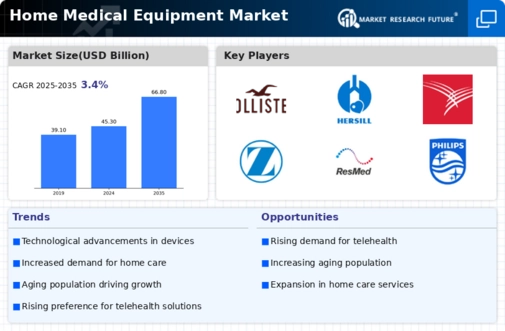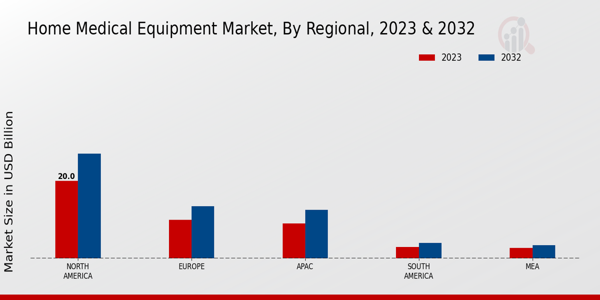Aging Population
The Global Home Medical Equipment Market Industry is experiencing a notable surge driven by the aging population. As individuals age, they often require medical assistance and equipment to maintain their health and independence. By 2024, the market is projected to reach 45.3 USD Billion, reflecting the increasing demand for home healthcare solutions. This demographic shift necessitates a variety of home medical equipment, including mobility aids, monitoring devices, and therapeutic tools. The growing number of elderly individuals, particularly in developed nations, underscores the importance of this market segment, as it seeks to enhance the quality of life for seniors while reducing the burden on healthcare systems.
Rising Chronic Diseases
The increasing prevalence of chronic diseases is a significant driver of the Global Home Medical Equipment Market Industry. Conditions such as diabetes, cardiovascular diseases, and respiratory disorders necessitate ongoing monitoring and management, which can often be conducted at home. This trend is likely to contribute to the market's growth, with projections indicating a rise to 66.8 USD Billion by 2035. Home medical equipment, including glucose monitors, oxygen concentrators, and blood pressure monitors, becomes essential for patients managing these conditions. The shift towards home-based care not only improves patient comfort but also reduces healthcare costs, making it a viable option for many individuals.
Market Growth Projections
The Global Home Medical Equipment Market Industry is poised for substantial growth, with projections indicating a market size of 45.3 USD Billion in 2024 and an anticipated increase to 66.8 USD Billion by 2035. This growth trajectory suggests a robust demand for various home medical devices, driven by factors such as an aging population, technological advancements, and rising chronic diseases. The expected CAGR of 3.6% from 2025 to 2035 further emphasizes the market's potential. As healthcare continues to evolve, the importance of home medical equipment will likely increase, reflecting a shift towards more patient-centered care models.
Technological Advancements
Technological innovations play a pivotal role in shaping the Global Home Medical Equipment Market Industry. The integration of smart technologies, such as telehealth solutions and remote monitoring systems, enhances patient care and facilitates better health outcomes. These advancements not only improve the efficiency of home healthcare but also empower patients to manage their conditions more effectively. As the market evolves, it is expected to grow at a CAGR of 3.6% from 2025 to 2035, indicating a sustained interest in innovative solutions. The proliferation of mobile health applications and wearable devices further illustrates the potential for technology to transform home medical equipment, making it more accessible and user-friendly.
Cost-Effectiveness of Home Care
The Global Home Medical Equipment Market Industry benefits from the increasing recognition of the cost-effectiveness of home care solutions. Home medical equipment allows patients to receive necessary care in a familiar environment, often at a lower cost than traditional hospital settings. This economic advantage is particularly appealing to healthcare providers and insurers, who are increasingly looking for ways to reduce expenditures. As a result, the demand for home medical equipment is expected to rise, driven by both patient preference and financial considerations. The market's growth trajectory is supported by the potential for home care to alleviate the strain on healthcare systems while providing quality care.
Government Initiatives and Support
Government initiatives and support are crucial drivers of the Global Home Medical Equipment Market Industry. Many governments are implementing policies aimed at promoting home healthcare services, recognizing the benefits of reducing hospital stays and improving patient outcomes. These initiatives often include funding for home medical equipment, subsidies for patients, and incentives for healthcare providers to adopt home care practices. Such support not only enhances access to necessary equipment but also encourages innovation within the industry. As the market continues to expand, government involvement will likely play a significant role in shaping its future, ensuring that patients receive the care they need in their homes.













